#Tripura Bhairavi
Explore tagged Tumblr posts
Text
Dashavatar and Das Mahavidyas I think would be besties (with barely any explanation why or maybe no explanation)*
Matsya – Lalita Tripura Sundari
Kurma – Tara (Samudra Manthan)
Varaha – Bhuvaneshwari
Vamana – Bagalamukhi
Narshimha – Chhinnamastaa (looks scary but are really nice, just don't piss them off)
Parashuram – Bhairavi (WAR BUDDIES)
Ram – Dhumavati (ahh the unfortunate widows...)
Krishna – Kali (“twin! Where have you been?”)
Buddha – Matangi
Kalki – Kamala
*IMPORTANT: This is not based on the actual association done on Dashavatar and Das Mahavidya. This is just how I thing who would be friends with whom.
#dashavatar#das mahavidya#matsya#kurma#varaha#vamana#narasimhadeva#shri ram#shri krishna#krishna#buddha#kalki#dhumavati#goddess kali#kamala#chhinnamastaa#bhairavi#bagalamukhi#matangi#bhuvaneshwari#lalita tripura sundari#tara#vishnu#hindu god#hindu goddess#hinduism#hindublr#hindu gods#desiblr#desi tumblr
69 notes
·
View notes
Text
మాఘ పౌర్ణమి, శ్రీ లలితా త్రిపుర భైరవి - శోడశి జయంతి / Magha Purnami, Sri Lalitha Tripura Bhairavi Jayanti (Shodashi Jayanthi)

🌹 మాఘ పౌర్ణమి, శ్రీ లలితా త్రిపుర భైరవి - శోడశి జయంతి శుభాకాంక్షలు అందరికి / Magha Purnami, Sri Lalitha - Shodashi Jayanthi Greetings to All 🌹 ✍️. ప్రసాద్ భరధ్వాజ
🌻 శ్రీ లలితా త్రిపుర భైరవి స్తోత్రం 🌻
బ్రహ్మాదయస్స్తుతి శతైరపి సూక్ష్మ రూపం జానంతినైవ జగదాది మనాదిమూర్తిమ్ |
తస్మాదమూం కుచనతాం నవ కుంకుమాస్యాం స్థూలాం స్తువే సకల వాఙ్మయ మాతృభూతామ్
☘️ మాఘస్నానం స్తోత్రం ☘️
"దుఃఖదారిద్యనాశాయ శ్రీవిష్ణోస్తోషణాయాచ
ప్రాతః స్నానం కరోమ్యద్య మాఘే పాప వినాశనం
మకరస్దే రవౌ మాఘే గోవిందాచ్యుత మాధవ
స్నానేనానేన మే దేవ యథోక్త ఫలదో భావ''
"దుఃఖములు , దారిద్య���రము నశించుటకు పాప క్షయమగుటకు శ్రీవిష్ణుప్రీతి పూర్వకముగ ఈ పవిత్ర మాఘ స్నానము చేయుచున్నాను.
🍀 శ్రీ లలితా త్రిపుర భైరవి - శోడశి జయంతి ప్రాముఖ్యత 🍀
శ్రీ లలితా త్రిపుర భైరవి జయంతి లేదా శోడశి జయంతి అని కూడా పిలువబడే ఈ పండుగ హిందూ సాంప్రదాయంలో ఎంతో ముఖ్యమైనదిగా భావించ బడుతుంది. మాఘ పౌర్ణమి నాడు ఇది నిర్వహిస్తారు. ఇది దశ మహావిద్యలలో ఒకరైన దేవి శోడశి జన్మదినాన్ని పురస్కరించుకొని జరుపుకునే పవిత్రమైన రోజు.
ఈ రోజున దేవి శ్రీ లలితా త్రిపుర భైరవి ఆరాధన చేయడం ద్వారా భక్తులు మోక్షాన్ని పొందుతారని విశ్వసిస్తారు. పూర్ణ విశ్వాసంతో మాతా లలితాను పూజించుట వలన జనన మరణ చక్రం నుండి విముక్తి లభిస్తుంది. అందువల్ల, లలితా జయంతి సందర్భంగా దేవి లలితాను గొప్ప భక్తితో ఆరాధిస్తారు. మాతా లలితాదేవిని పూజను చేస్తే అన్ని విధాలైన సిద్ధులను పొందగలుగుతారు.
ఈ రోజు సౌందర్యం, శక్తి, కృప యొక్క పరాకాష��టగా భావించబడే దేవి శోడశిని ఘనంగా ఆరాధిస్తారు. ఆమె పూజకు గొప్ప ఆధ్యాత్మిక ప్రాముఖ్యత ఉంది. భక్తులు ఆమె అనుగ్రహాన్ని కోరుకుంటూ కుటుంబ సమతుల్యత, ఆధ్యాత్మిక అభివృద్ధి, కళల్లో పరిపూర్ణత సాధించే ఆశయంతో ఉపాసన చేస్తారు.
శోడశి జయంతి అనేది భక్తి మరియు భయభక్తులతో శ్రీ లలితా త్రిపుర భైరవిని ఆరాధించే ప్రత్యేకమైన రోజు. ఈ పండుగ ప్రాముఖ్యత ఆమె ఆరాధన ద్వారా భుక్తి (లోక సంబంధమైన ఆనందాలు) మరియు ముక్తి (ఆధ్యాత్మిక విముక్తి) రెండింటినీ పొందే అవకాశాన్ని అందించడంలో ఉంది. భక్తులు ఆమె కృపను కోరుకోవడం ద్వారా ఇంద్రియాలపై నియంత్రణ పొందగలుగుతారని, తేజస్సును పొందగలుగుతారని, కుటుంబ జీవితంలో సమతుల్యతను అనుభవించ గలుగుతారని భక్తులు విశ్వసిస్తారు.
దేవి శోడశి మహాత్రిపుర సుందరి, లలితా, బాలా పంచదశి, రాజరాజేశ్వరీ వంటి అనేక పేర్లతో ప్రసిద్ధి చెందింది. శ్రీమాత సంప్రదాయంలోని దశ మహావిద్యలలో మూడవ మహావిద్యగా పరిగణించ బడతుంది. భూలోకం, స్వర్గలోకం, పాతాళ లోకాల్లోనే అత్యంత శోభాయమానమైన మరియు శక్తివంతమైన దేవతగా ఆమెను భావిస్తారు. శరీర సౌందర్యానికి మాత్రమే కాక, పరమార్ధ సాధన, ఆధ్యాత్మిక మేల్కొలుపు, దైవ రక్షణను ప్రసాదించే దేవతగా ఆమెను ఆరాధిస్తారు.
🌹🌹🌹🌹🌹
#prasad bharadwaj#మాఘ పౌర్ణమి Magha Pournami#Shodashi Jayanti#శ్రీ త్ర���పుర భైరవి జయంతి Sri Tripura Bhairavi Jayanti#Prasad Bharadwaj#lalitha chaitanya sahasranama contemplation#lalita devi#lalitha devi#message of the day#hindus#hindu gods#hinduism#sanatana#sanatandharma#telugu stories#telugu#telugunews
0 notes
Text
@h0bg0blin-meat
I finished the drawing

Also, figuring how to design stuff took so long I started drawing in the Mahavidyas too

#durga#mahavidya#kali#tara#sodashi#tripura sundari#bhuvaneshwari#bhairavi#chhinnamasta#dhumavati#bagalamukhi#matangi#kamalatmika#hindu goddess#hindublr#desiblr#my art#bluboi art
26 notes
·
View notes
Text
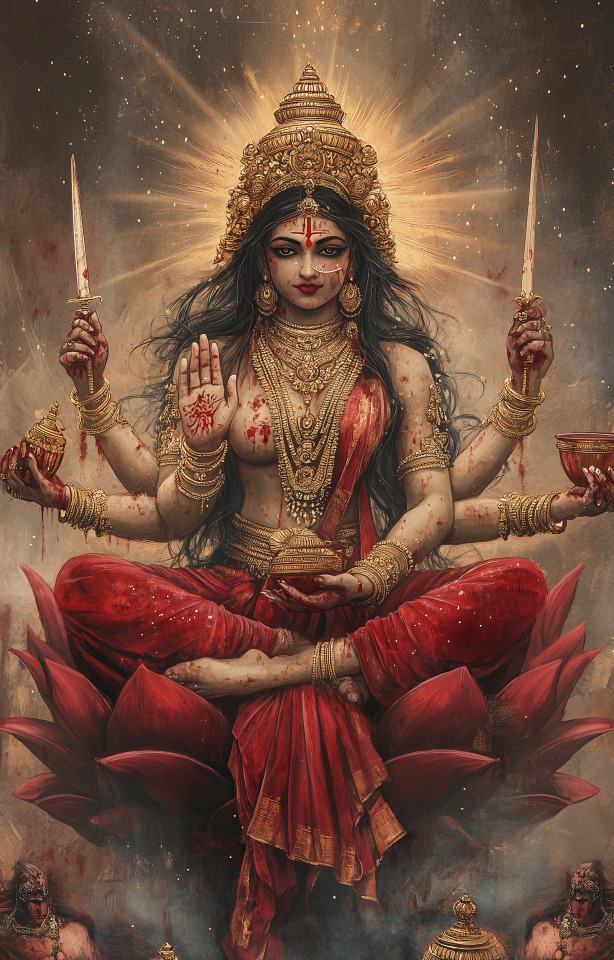
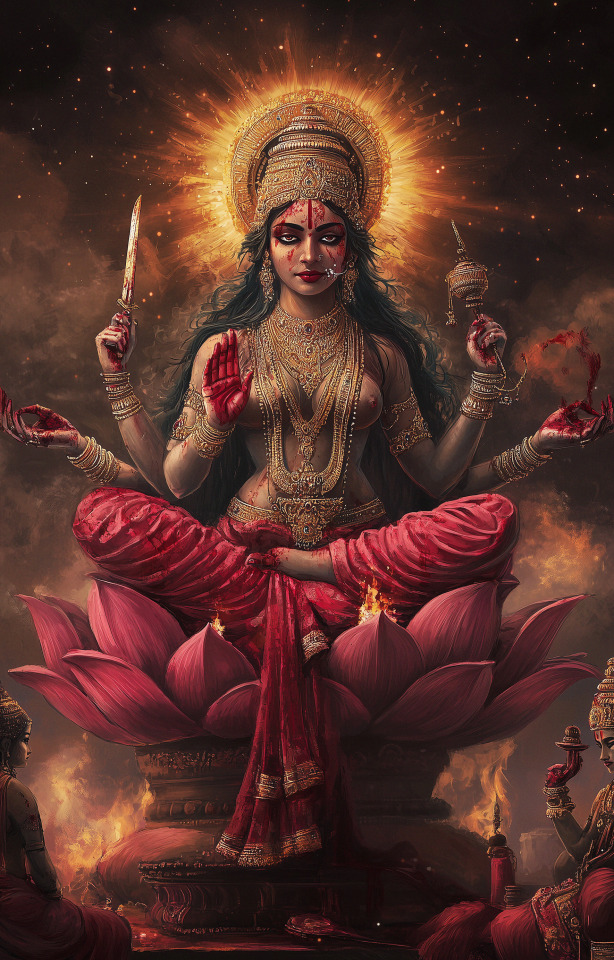
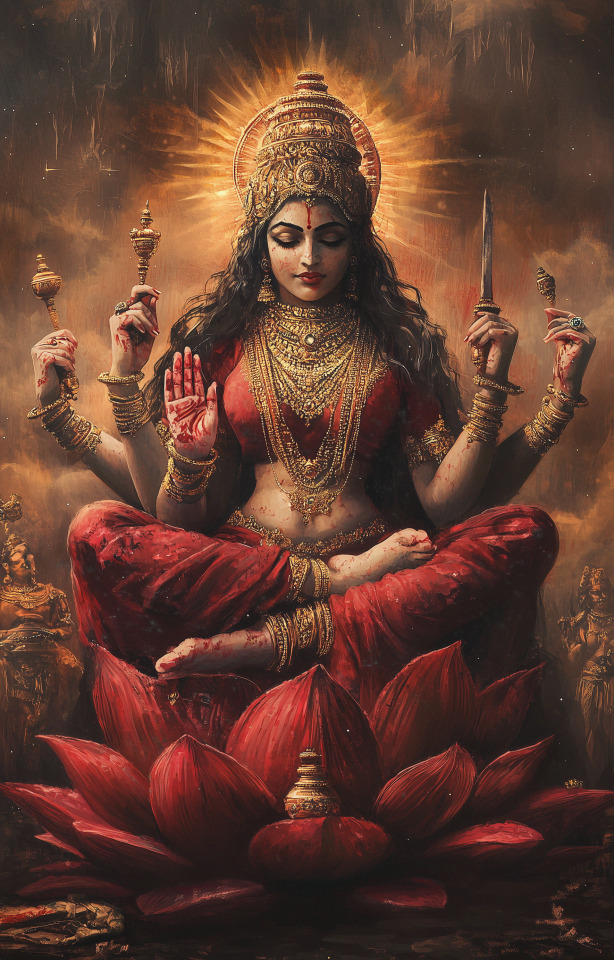
Goddess Bhairavi Talon Abraxas
Devi Bhairavi - The Most Powerful Tantric Goddess
Who is Mahavidya Tripura Bhairavi?
Devi Bhairavi, the fifth of Mahavidyas, is the goddess of creation, maintenance, and destruction. The name Bhairavi means “frightful,” “terrible,” “horrible,” or “formidable.” Devi Bhairavi is a fierce goddess whose name brings fear in all three worlds.
Bhairavi is responsible for creating that is followed by destruction. She is also known as Tripura Bhairavi, which is associated with three lokas or three worlds.
She bears aspects of Agni (Fire), Vidyut (lightning), and Surya (Sun), encompassing gods like Indra, Surya, and Agni. She is the goddess of Kundalini, a divine form of energy situated as the base of the spine. This is also why worshiping Devi Bhairavi almost always consists of meditation which will help awaken Kundalini.
The goddess of destruction is the consort of Kala Bhairava, the aggressive form of Lord Shiva hence also known as Kala Bhairavi. Goddess Kali is known as the most primordial form of energy (Adi Shakti). She is worshiped in ten different forms known as Dasa Mahavidyas, the fifth of which is Bhairavi. That is also the reason she shares so many characteristics with Goddess Kali. She glorifies the supreme power of speech, which is empowered by the ferocity of the burning fire, Tejas.
She is a feared goddess by all doers of evil as well as good. Though fearsome, her only motive is to continue the cycle of destruction and creation in this world. She is a mother who has unconditional love for all her children and can go to any limits to protect her beloved. A famous deity in Tantra Vidhya, goddess bhairavi holds a special position in all forms of worship.
Unlike the Trinity-god Brahma, Vishnu, and Shiva, who control one form of life and world creation, maintenance, and destruction, goddess bhairavi has control over all three aspects of life. She is a fierce form of the goddess, but she has great consciousness, which is remarkable. She dispels negative forces that try to curb spiritual growth.
Devi Bhairavi Mantras to Chant for Transformation: Bhairavi Mool Mantra ॐ ह्रीं भैरवी कलौं ह्रीं स्वाहा॥ Om Hreem Bhairavi Kalaum Hreem Svaha॥
“ॐ” is a sacred sound, known as the primordial sound of the universe in Hinduism, Buddhism, and Jainism. “ह्रीं” (pronounced as “hreem”) is a seed (bija) mantra associated with Shakti.
“भैरवी” is a term used to refer to the Goddess Parvati in her fierce form. “कलौं” is a bija mantra often used in tantric practices, associated with time and change. “स्वाहा” (pronounced as “swaha”) is often used at the end of mantras during ritualistic worship.
37 notes
·
View notes
Text

“Every act of creation is first an act of destruction.” — Pablo Picasso
Devi Bhairavi - The Most Powerful Tantric Goddess
Who is Mahavidya Tripura Bhairavi?
Devi Bhairavi, the fifth of Mahavidyas, is the goddess of creation, maintenance, and destruction. The name Bhairavi means “frightful,” “terrible,” “horrible,” or “formidable.” Devi Bhairavi is a fierce goddess whose name brings fear in all three worlds.
Bhairavi is responsible for creating that is followed by destruction. She is also known as Tripura Bhairavi, which is associated with three lokas or three worlds.
She bears aspects of Agni (Fire), Vidyut (lightning), and Surya (Sun), encompassing gods like Indra, Surya, and Agni. She is the goddess of Kundalini, a divine form of energy situated as the base of the spine. This is also why worshiping Devi Bhairavi almost always consists of meditation which will help awaken Kundalini.
The goddess of destruction is the consort of Kala Bhairava, the aggressive form of Lord Shiva hence also known as Kala Bhairavi. Goddess Kali is known as the most primordial form of energy (Adi Shakti). She is worshiped in ten different forms known as Dasa Mahavidyas, the fifth of which is Bhairavi. That is also the reason she shares so many characteristics with Goddess Kali. She glorifies the supreme power of speech, which is empowered by the ferocity of the burning fire, Tejas.
She is a feared goddess by all doers of evil as well as good. Though fearsome, her only motive is to continue the cycle of destruction and creation in this world. She is a mother who has unconditional love for all her children and can go to any limits to protect her beloved. A famous deity in Tantra Vidhya, goddess bhairavi holds a special position in all forms of worship.
Unlike the Trinity-god Brahma, Vishnu, and Shiva, who control one form of life and world creation, maintenance, and destruction, goddess bhairavi has control over all three aspects of life. She is a fierce form of the goddess, but she has great consciousness, which is remarkable. She dispels negative forces that try to curb spiritual growth.
Image: Goddess Bhairavi Art by Mahaboka
15 notes
·
View notes
Text

Bhairavi is a tantric Goddess, who is the part of the Ten Mahavidyas’ group (Dasha-mahavidya). She is also known as Tripura Bhairavi. Varahi Tantra says, “Since She was worshipped by Brahma, Vishnu and Mahesh in earlier times, She became known by the name Tripura”.
Usually, in various tantric texts and hymns in Her honor, many amasing forms of the Goddess are described, whose names indicate various graces for the sadhakas devoted to Her. In particular, it grants various kinds of siddhis and magical perfections, as well as the ability to control sexual energy, the power of fearlessness, protection from negative influences and cutting off worldly attachments.
By controlling tanmatras (properties of objects perceived by the five senses: hearing, touch, sight, taste and smell), She allows to control five kinds of gross elements and five kinds of perception. As kriya-shakti, Bhairavi symbolises the power of the ascending Kundalini, which is awakened with the help of Bhairava-sadhana (Shiva-Bhairava is the consort of the Goddess), characteristic of vamachara practices. In the yogic context, such sadhana is an internal work for the unification of prana and apana in the sushumna channel.
In the Sharada-tilaka hymn, Bhairavi is described as a fire that consumes the entire universe at the end of each cosmic cycle, since at the levels of macro- and micro-cosmic processes she performs the threefold function of creation-preservation-destruction (srishti, sthiti and pralaya).
The majority of the people perceive the action extraordinary divine force and energy of this Goddess as a scaring aspect, mostly because she causes the destruction of all limitations, preconceived ideas, erroneous conceptions and illusions regarding our individual existence. But, Bhairavi is the sacred connection with the school, Guru, Tradition; it is the transfiguration of the mundane into the transcendent.
https://nathas.org/en/
9 notes
·
View notes
Text
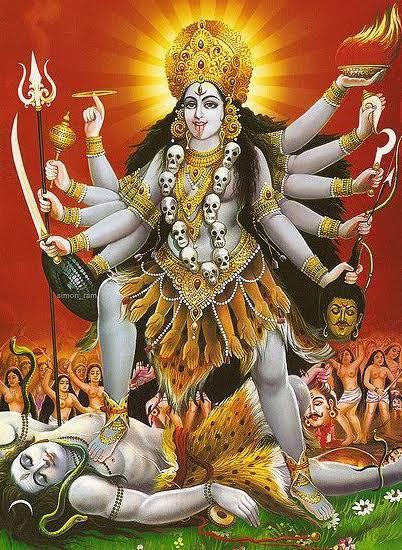
Das Mahavidya course
Many ask me if Sri Vidya is a part of Das Mahavidya? No it is not it is much more than Sri Vidya in fact. Be it Sri Vidya, shri chakram, brahma Vidya many forms learn Das Mahavidya at end as it’s the most powerful form of all the vidyas.
DAS MAHAVIDYA actually means knowledge of ten great vidyas. Devi maha mantras are known as vidyas of the ten devis. Kali, Tara, Tripura Sundari, Bhuvaneswari, Tripura Bhairavi, Chinnamasta, Dhumavati, Bhaglamukhi, Matangi and Kamalatmika are the ten most powerful shaktis which you learn.
First Devi the Kali who first took form in the Das Mahavidya she teaches us how to overcome greed, anger and handle crisis in life. The right upasanas and chanting will make you come out of all issues in life.
What more is needed if you feel she is your mother, ur kul Devi or when you see her you feel safe than learn the right way to pray to her.
Selection process have started so you can connect with me for the selection forms at 9176231990
#magickofhealing#punjabipinky#wiccabypinkypunjabi#goddess#occult#spirituality#hinduism#maa kali#matangi#lord shiva#mahakaal#mahakali
18 notes
·
View notes
Text
THE DUS MAHAVIDYAS IN TANTRA SADHANA
The Dus Mahavidyas, or the "Ten Great Wisdom Goddesses," are a group of ten aspects of the Divine Mother or the Supreme Goddess in Hindu Tantric tradition. Each Mahavidya represents a distinct manifestation of cosmic energy (Shakti) and embodies different attributes, ranging from the fierce to the benevolent. These goddesses are central to Tantra Sadhana (spiritual practice), as they symbolize various aspects of consciousness, transformation, and the cycle of creation and destruction.
The Ten Mahavidyas
1. Kali – The fierce goddess of time and change, often depicted with a dark, terrifying form. Kali represents the power of destruction, necessary for renewal and transformation. She is also the force that dissolves the ego, helping the practitioner transcend the material world.
2. Tara – The goddess of compassion and protection. She guides devotees through difficult times and leads them toward spiritual liberation. Tara is often seen as a savior figure who can ferry people across the ocean of suffering.
3. Tripura Sundari (Shodashi) – The goddess of supreme beauty and grace, also known as Lalita. She represents the energy of divine love, beauty, and creative power. She embodies the fullness of bliss and consciousness and is associated with spiritual attainment.
4. Bhuvaneshwari – The goddess of the universe or space (Bhuvana). She is the embodiment of the cosmos, representing the space within which all creation takes place. In Tantra, she symbolizes the realization of the unity of the self with the cosmos.
5. Bhairavi – The fierce and fiery goddess of destruction, similar to Kali but more directly associated with personal empowerment and inner fire. Bhairavi is the force that burns away ignorance and ego, transforming the practitioner’s consciousness.
6. Chhinnamasta – The self-decapitated goddess who symbolizes the cutting off of the ego and the realization of the void (Shunya). She is a symbol of self-sacrifice and awakening, teaching the balance between creation and destruction in the spiritual journey.
7. Dhumavati – The goddess of poverty, darkness, and death, representing the inauspicious aspects of existence. Dhumavati shows the devotee the reality of suffering and the impermanence of life, guiding them to transcend worldly attachments.
8. Bagalamukhi – The goddess of paralyzing speech and action. She is worshipped to gain control over enemies, both external and internal (such as negative thoughts). Bagalamukhi represents the power of stillness and the ability to immobilize obstacles in the path of spiritual progress.
9. Matangi – The goddess of inner knowledge, speech, and music. Matangi is associated with the power of thought, communication, and creativity. She represents the outcast and those who live outside societal norms, showing that wisdom can be found in unconventional places.
10. Kamala – The goddess of wealth, abundance, and prosperity, similar to Lakshmi. Kamala embodies material and spiritual wealth, showing that prosperity is not separate from the divine but can be integrated into spiritual practice.
Tantra Sadhana with the Mahavidyas
In Tantra Sadhana, practitioners engage in rituals, meditations, and mantras specific to each Mahavidya to unlock her unique powers and qualities within themselves. These practices often involve:
1. Mantra Japa – Reciting specific mantras associated with each Mahavidya.
2. Yantra Puja – Worshipping sacred geometric diagrams (yantras) representing the goddess.
3. Visualization – Meditating on the form of the Mahavidya, her attributes, and her qualities to invoke her presence.
4. Offerings – Presenting items like flowers, incense, and food to the goddess as a form of devotion.
5. Tarpana (Offering of Water) – Offering water to the goddess as a form of purification.
Symbolism and Significance
The Mahavidyas collectively represent a complete spectrum of divine energy, including the dark, the fierce, the nurturing, and the compassionate. They symbolize the multifaceted nature of reality and consciousness. Through the worship of these goddesses, practitioners aim to overcome dualities, such as good and evil, creation and destruction, or pleasure and pain, and experience the non-dual nature of the Divine.
Liberation from Fear: Many of these goddesses represent terrifying forms of the Divine, but their worship is intended to help the practitioner overcome fear and attachment, leading to spiritual liberation (Moksha).
Transformative Power: The Mahavidyas are seen as powers of transformation, both at the personal and cosmic levels. They help the sadhaka (practitioner) face and transform their deepest fears, desires, and ignorance.
Inner and Outer Wisdom: The Mahavidyas offer wisdom not just in the spiritual sense, but also in worldly matters, such as success, prosperity, and relationships. The practices associated with each Mahavidya lead to insights that help balance spiritual growth with worldly responsibilities.
The Dus Mahavidyas are powerful goddesses who represent the diverse manifestations of Shakti in Tantra. Worshipping these goddesses in Tantra Sadhana is a path to deeper self-realization, the transcendence of ego, and the ultimate experience of divine unity. Each Mahavidya has her own unique energy, teachings, and sadhana methods, and together they provide a comprehensive spiritual path for the practitioner.
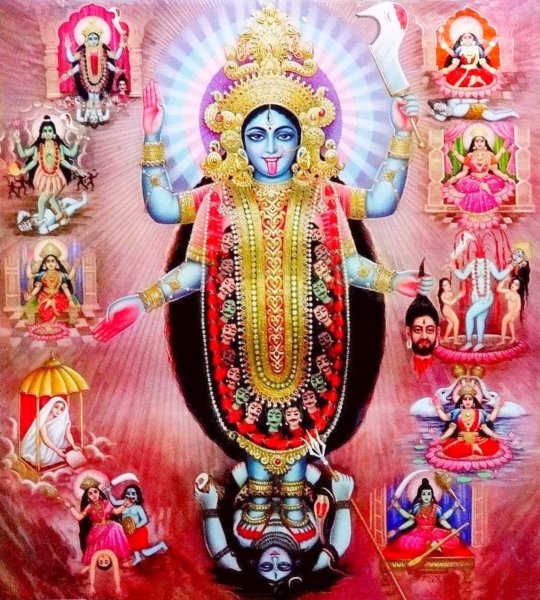
10 notes
·
View notes
Text
The Mahavidya (Sanskrit: महाविद्या, IAST: Mahāvidyā, lit. Great Wisdoms) are a group of ten Hindu[1] Tantric goddesses.[2] The 10 Mahavidyas are usually named in the following sequence: Kali, Tara, Tripura Sundari, Bhuvaneshvari, Bhairavi , Chhinnamasta, Dhumavati, Bagalamukhi, Matangi and Kamala.[3] Nevertheless, the formation of this group encompass divergent and varied religious traditions that include yogini worship, Saivism, Vaishnavism, and Vajrayana Buddhism.[4]
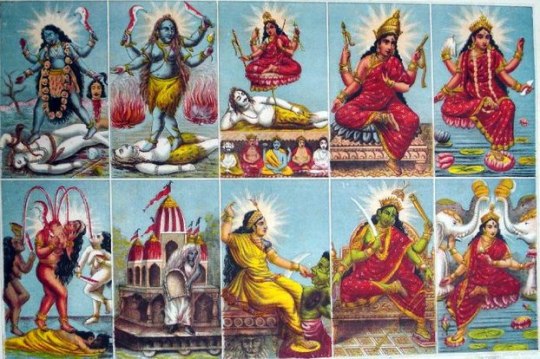
Shaktas believe, "the one Truth is sensed in ten different facets; the Divine Mother is adored and approached as ten cosmic personalities," the Dasa-Mahavidya ("ten-Mahavidyas").[6] As per another school of thought in Shaktism Mahavidyas are considered to be form of Mahakali. The Mahavidyas are considered Tantric in nature, and are usually identified as:[7
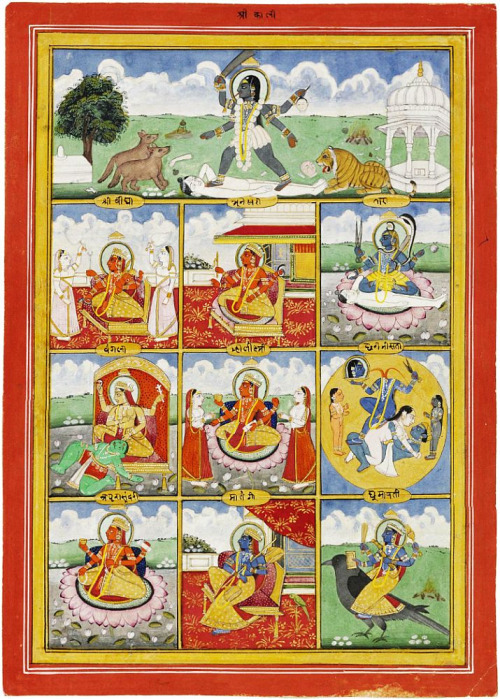
1. Kali: The goddess who is the ultimate form of Brahman, and the devourer of time (Supreme Deity of Kalikula systems). Mahakali is of a pitch black complexion, darker than the dark of the dead of the night. She has three eyes, representing the past, present and future. She has shining white, fang-like teeth, a gaping mouth, and her red, bloody tongue hanging from there. She has unbound, disheveled hairs. She wears tiger skins as her garments, a garland of skulls and a garland of rosy red flowers around her neck, and on her belt, she was adorned with skeletal bones, skeletal hands as well as severed arms and hands as her ornamentation. She has four hands, two of them had the trident called the trishula and the sword and two others carried a demon head and a bowl collecting the blood dripping from a demon head.
2. Tara: The goddess who acts as a guide and a protector, and she who offers the ultimate knowledge that grants salvation. She is the goddess of all sources of energy. The energy of the sun is believed to originate from her. She manifested as the mother of Shiva after the incident of Samudra Manthana to heal him as her child. Tara is of a light blue complexion. She has disheveled hair, wearing a crown decorated with the digit of the half-moon. She has three eyes, a snake coiled comfortably around her throat, wearing the skins of tigers, and a garland of skulls. She is also seen wearing a belt supporting her skirt made of tiger-skin. Her four hands carry a lotus, scimitar, demon head and scissors. Her left foot rests on the laying down Shiva.
3. Tripura Sundari (Shodashi, Lalita): The goddess who is "beauty of the three worlds" (Supreme Deity of Srikula systems); the "Tantric Parvati" or the "Moksha Mukta". She is the ruler of Manidvipa, the eternal supreme abode of the goddess. Shodashi is seen with a molten gold complexion, three placid eyes, a calm mien, wearing red and pink vestments, adorned with ornaments on her divine limbs and four hands, each holding a goad, lotus, a bow, and arrow. She is seated on a throne.
4. Bhuvaneshvari: The goddess as the world mother, or whose body comprises all the fourteen lokas of the cosmos. Bhuvaneshvari is of a fair, golden complexion, with three content eyes as well as a calm mien. She wears red and yellow garments, decorated with ornaments on her limbs and has four hands. Two of her four hands hold a goad and noose while her other two hands are open. She is seated on a divine, celestial throne.
5. Bhairavi: The fierce goddess. The female version of Bhairava. Bhairavi is of a fiery, volcanic red complexion, with three furious eyes, and disheveled hair. Her hair is matted, tied up in a bun, decorated by a crescent moon as well as adorning two horns, one sticking out from each side. She has two protruding tusks from the ends of her bloody mouth. She wears red and blue garments and is adorned with a garland of skulls around her neck. She also wears a belt decorated with severed hands and bones attached to it. She is also decked with snakes and serpents too as her ornamentation – rarely is she seen wearing any jewelry on her limbs. Of her four hands, two are open and two hold a rosary and book.
6. Chhinnamasta: The self-decapitated goddess. She chopped her own head off in order to satisfy Jaya and Vijaya (metaphors of rajas and tamas - part of the trigunas). Chinnamasta has a red complexion, embodied with a frightful appearance. She has disheveled hair. She has four hands, two of which hold a sword and another hand holding her own severed head; three blazing eyes with a frightful mien, wearing a crown. Two of her other hands hold a lasso and drinking bowl. She is a partially clothed lady, adorned with ornaments on her limbs and wearing a garland of skulls on her body. She is mounted upon the back of a copulating couple.
7. Dhumavati: The widow goddess. Dhumavati is of a smoky dark brown complexion, her skin is wrinkled, her mouth is dry, some of her teeth have fallen out, her long disheveled hair is gray, her eyes are seen as bloodshot and she has a frightening mien, which is seen as a combined source of anger, misery, fear, exhaustion, restlessness, constant hunger and thirst. She wears white clothes, donned in the attire of a widow. She is sitting in a horseless chariot as her vehicle of transportation and on top of the chariot, there is an emblem of a crow as well as a banner. She has two trembling hands, her one hand bestows boons and/or knowledge and the other holds a winnowing basket.
8. Bagalamukhi: The goddess who paralyzes enemies. Bagalamukhi has a molten gold complexion with three bright eyes, lush black hair and a benign mien. She is seen wearing yellow garments and apparel. She is decked with yellow ornaments on her limbs. Her two hands hold a mace or club and holds demon Madanasura by the tongue to keep him at bay. She is shown seated on either a throne or on the back of a crane.
9. Matangi: The Prime Minister of Lalita (in Srikula systems), sometimes called the "Tantric Saraswati". Matangi is depicted as emerald green in complexion, with lush, disheveled black hair, three placid eyes and a calm look on her face. She is seen wearing red garments and apparel, bedecked with various ornaments all over her delicate limbs. She is seated on a royal throne and she has four hands, three of which hold a sword or scimitar, a skull and a veena (a musical instrument). Her one hand bestows boons to her devotees.
10. Kamalatmika (Kamala): The lotus goddess; sometimes called the "Tantric Lakshmi". Kamala is of a molten gold complexion with lush black hair, three bright, placid eyes, and a benevolent expression. She is seen wearing red and pink garments and apparel and bedecked with various ornaments and lotuses all over her limbs. She is seated on a fully bloomed lotus, while with her four hands, two hold lotuses while two grant her devotees' wishes and assures protection from fear.
All these Mahavidyas reside in Manidvipa.
The Mahabhagavata Purana and Brihaddharma Purana however, list Shodashi (Sodasi) as Tripura Sundari, which is simply another name for the same goddess.[9] The Guhyati guyha-tantra associates the Mahavidyas with the Dashavatara, the ten avatars of Vishnu, and states that the Mahavidyas are the source from which the avatars of Vishnu arise.
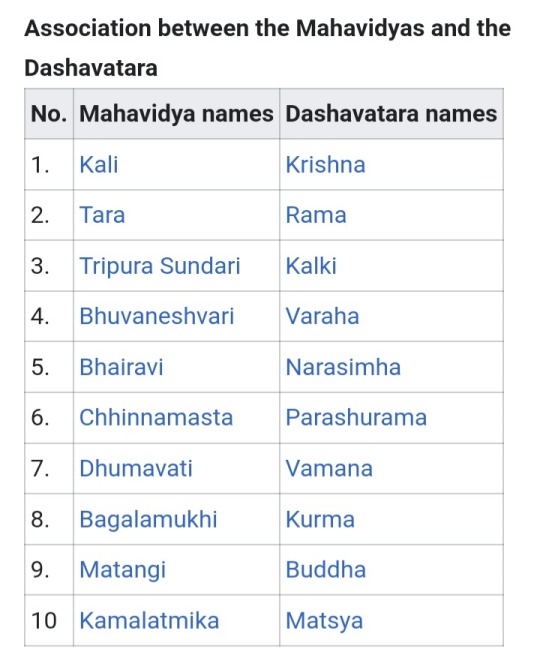
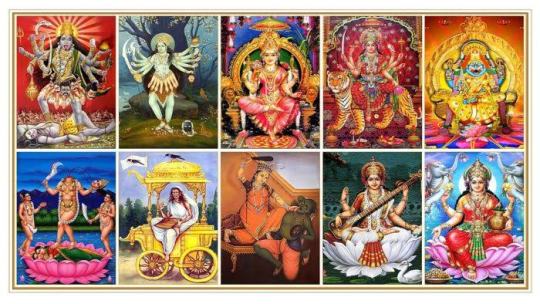

#desi aesthetic#desi tag#desiblr#desi#desi dark academia#desi culture#desi academia#desi stuff#hindu mythology#south asian aesthetic#south asian dark academia#aloukik 2023
45 notes
·
View notes
Note
I made a Pinterest side account (or whatever it's called over there) for Durga and the Mahavidyas' aesthetics
I started yesterday, and it's mostly a WIP
https://in.pinterest.com/Aesthetics_Devi/
OMG OMG OMG I JUST SAW THAT ALL OF THE ARE SO SO SO BEAUTIFUL 😭😭😭😭😭
@h0bg0blin-meat @hydestudixs
#das mahavidya#maa durga#matangi#tara#lalita tripura sundari#kali#kamala#dhumavati#bhairavi#baglamukhi#bhubaneswari#chhinnamasta#hindu goddess#durga#goddess durga#goddess kali#hindu gods#hindublr
11 notes
·
View notes
Text
Die Mahavidyas (von Sanskrit महाविद्या Mahāvidyā = „große Verkörperung“ oder „großes Wissen“) sind eine Gruppe von zehn tantrischen Göttinnen, von denen die meisten in zornvollen und schrecklichen Formen erscheinen: Kali, Tara, Chinnamasta, Bhuvaneshvari, Bagala, Dhumavati, Kamala, Mitangi, Sodashi (auch Sundari) und Bhairavi oder Tripura Bhairavi.
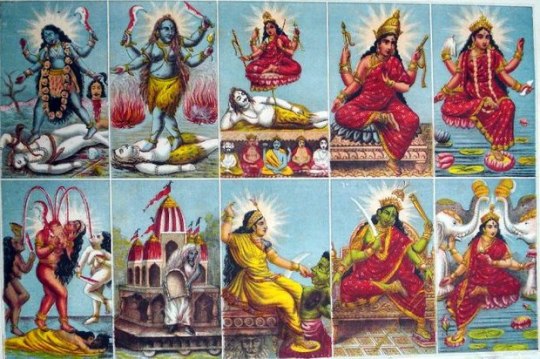
In diesen Mythen spielen die Mahavidyas die Rolle, zu zeigen, dass das Weibliche selbst stärker ist als Shiva und die anderen männlichen Götter, und es liegt nahe anzunehmem, dass die Shaktas die Überlegenheit der Mahadevi zeigen wollten.
2 notes
·
View notes
Text
Mahavidya Tripura Bhairavi like you've never seen before
youtube
TUM SABB MERE JAAGEER MEIN HO...
0 notes
Video
youtube
Mahavidya Tripura Bhairavi like you've never seen before
0 notes
Text
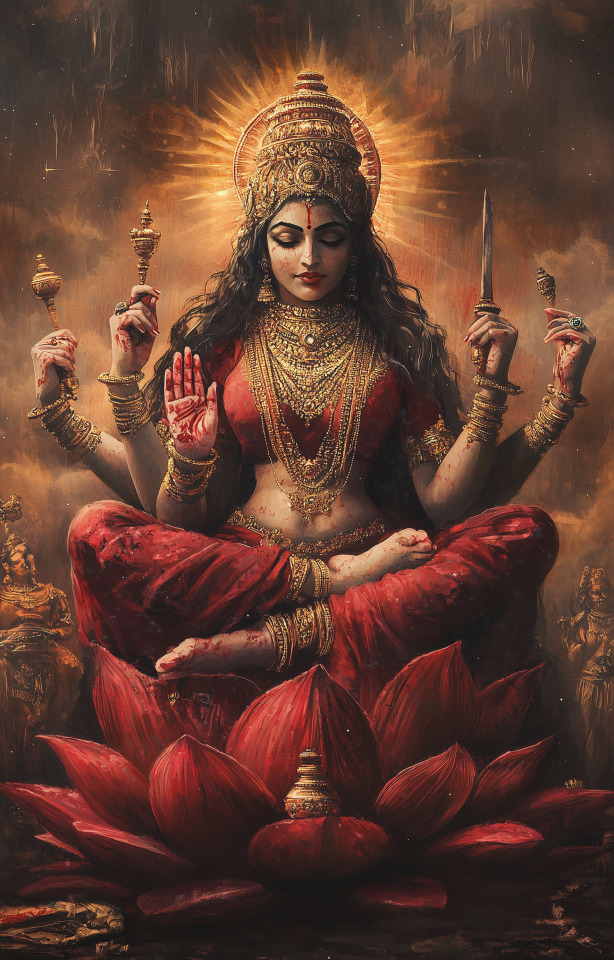
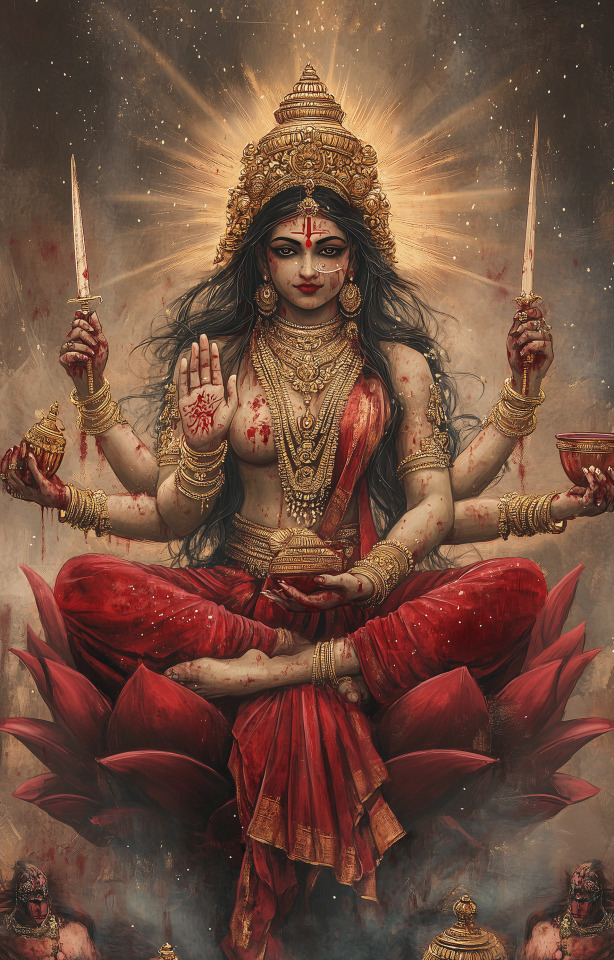
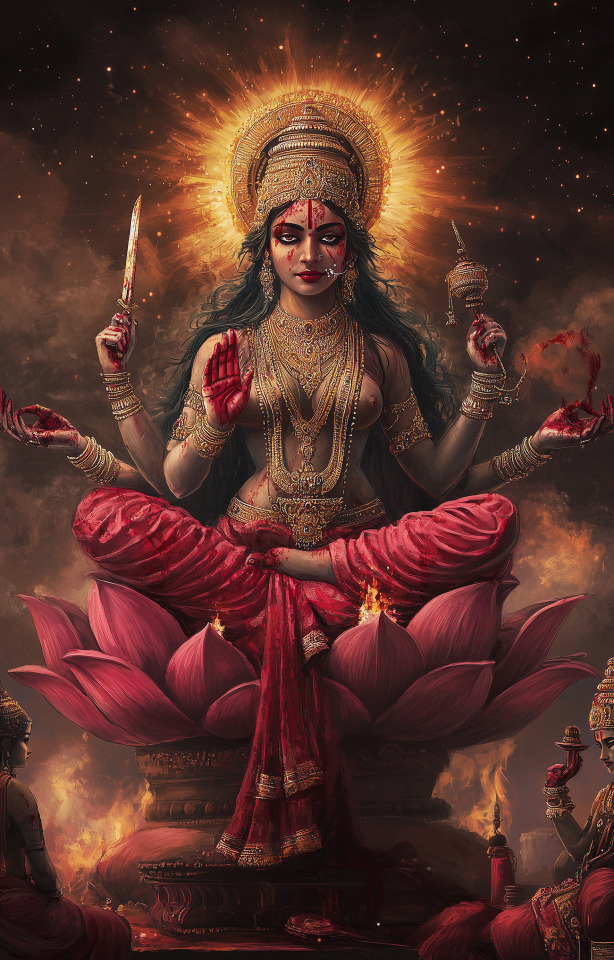
Goddess Bhairavi Talon Abraxas
Devi Bhairavi - The Most Powerful Tantric Goddess
Who is Mahavidya Tripura Bhairavi?
Devi Bhairavi, the fifth of Mahavidyas, is the goddess of creation, maintenance, and destruction. The name Bhairavi means “frightful,” “terrible,” “horrible,” or “formidable.” Devi Bhairavi is a fierce goddess whose name brings fear in all three worlds.
Bhairavi is responsible for creating that is followed by destruction. She is also known as Tripura Bhairavi, which is associated with three lokas or three worlds.
She bears aspects of Agni (Fire), Vidyut (lightning), and Surya (Sun), encompassing gods like Indra, Surya, and Agni. She is the goddess of Kundalini, a divine form of energy situated as the base of the spine. This is also why worshiping Devi Bhairavi almost always consists of meditation which will help awaken Kundalini.
The goddess of destruction is the consort of Kala Bhairava, the aggressive form of Lord Shiva hence also known as Kala Bhairavi. Goddess Kali is known as the most primordial form of energy (Adi Shakti). She is worshiped in ten different forms known as Dasa Mahavidyas, the fifth of which is Bhairavi. That is also the reason she shares so many characteristics with Goddess Kali. She glorifies the supreme power of speech, which is empowered by the ferocity of the burning fire, Tejas.
She is a feared goddess by all doers of evil as well as good. Though fearsome, her only motive is to continue the cycle of destruction and creation in this world. She is a mother who has unconditional love for all her children and can go to any limits to protect her beloved. A famous deity in Tantra Vidhya, goddess bhairavi holds a special position in all forms of worship.
Unlike the Trinity-god Brahma, Vishnu, and Shiva, who control one form of life and world creation, maintenance, and destruction, goddess bhairavi has control over all three aspects of life. She is a fierce form of the goddess, but she has great consciousness, which is remarkable. She dispels negative forces that try to curb spiritual growth.
Devi Bhairavi Mantras to Chant for Transformation: Bhairavi Mool Mantra ॐ ह्रीं भैरवी कलौं ह्रीं स्वाहा॥ Om Hreem Bhairavi Kalaum Hreem Svaha॥
“ॐ” is a sacred sound, known as the primordial sound of the universe in Hinduism, Buddhism, and Jainism. “ह्रीं” (pronounced as “hreem”) is a seed (bija) mantra associated with Shakti.
“भैरवी” is a term used to refer to the Goddess Parvati in her fierce form. “कलौं” is a bija mantra often used in tantric practices, associated with time and change. “स्वाहा” (pronounced as “swaha”) is often used at the end of mantras during ritualistic worship.
39 notes
·
View notes
Text

Devi Bhairavi, the fifth of Mahavidyas, is the goddess of creation, maintenance, and destruction. The name Bhairavi means “frightful,” “terrible,” “horrible,” or “formidable.” Devi Bhairavi is a fierce goddess whose name brings fear in all three worlds.
Bhairavi is responsible for creating that is followed by destruction. She is also known as Tripura Bhairavi, which is associated with three lokas or three worlds.
Bhairavi in Tantra Vidhya
She is a form of great cosmic consciousness and is considered one of the most powerful Tantric Goddesses among Das Mahavidhya. She is a mother who could go through anything to protect her children.
In Tantra Vidhya, she is the raw form of power. She is associated with many tantric kriyas like bhairavi kriya. Those performing these kriyas focus all forms of energy of light, fire, and earth into one. She also has control over reincarnation and one’s movement into three different worlds.
Jai Bhairavi Devi Mahā Nandini Namah Shri
Devi Bhairavi – The Most Powerful Tantric Goddess Image: Devi Bhairavi Mahaboka
5 notes
·
View notes
Text
Harness the Power of Sacred Yantras for Divine Blessings

Yantras are powerful spiritual tools that help channel divine energies, bringing prosperity, protection, and harmony. At Loka Lalitha Ambika Yantras And Sadhanas, we offer energized and authentic Yantras that assist in achieving spiritual and material growth. Each Yantra is imbued with sacred vibrations to manifest positivity in your life. Let’s explore their unique benefits.
Shree Sampoorna Yantra
The Shree Sampoorna Yantra is a combination of multiple sacred Yantras, ensuring overall well-being and success.
Benefits:
Complete Prosperity: Attracts abundance, health, and happiness.
Negativity Removal: Eliminates obstacles and enhances positive vibrations.
Peace & Harmony: Promotes stability in personal and professional life.
For more benefits please call our Guru Ji - +91-930-927-1927
Shree Seethala Yantra
The Shree Seethala Yantra is dedicated to Goddess Seethala Devi and is known for providing protection against diseases and ailments.
Benefits:
Health & Well-being: Protects against illnesses and enhances immunity.
Emotional Stability: Brings peace, reducing stress and anxiety.
Divine Protection: Wards off negative energies and evil influences.
For more benefits please call our Guru Ji - +91-930-927-1927
Shree Sukta Yantra
The Shree Sukta Yantra is associated with Goddess Lakshmi, attracting wealth and prosperity.
Benefits:
Financial Growth: Increases income and wealth accumulation.
Success in Business: Enhances career and business opportunities.
Positive Energy: Purifies the aura, removing negativity.
For more benefits please call our Guru Ji - +91-930-927-1927
Shree Tripura Bhairavi Yantra
The Shree Tripura Bhairavi Yantra is a powerful Yantra for spiritual elevation and overcoming obstacles.
Benefits:
Spiritual Awakening: Enhances meditation and deepens divine connection.
Fearlessness & Strength: Empowers the devotee with courage and confidence.
Obstacle Removal: Clears hurdles in both personal and professional life.
For more benefits please call our Guru Ji - +91-930-927-1927
Shree Tripura Sundari Yantra
The Shree Tripura Sundari Yantra is revered for enhancing beauty, love, and attraction.
Benefits:
Harmonious Relationships: Strengthens love and personal connections.
Magnetic Aura: Enhances charm, self-confidence, and inner glow.
Inner Peace & Joy: Helps in achieving emotional balance and happiness.
For more benefits please call our Guru Ji - +91-930-927-1927
Ashta Lakshmi Yantra
The Ashta Lakshmi Yantra invokes the blessings of the eight forms of Goddess Lakshmi, ensuring complete prosperity.
Benefits:
Wealth & Abundance: Brings financial growth and success in endeavors.
Good Health & Longevity: Promotes overall physical and mental well-being.
Fulfillment of Desires: Helps in achieving aspirations and personal goals.
For more benefits please call our Guru Ji - +91-930-927-1927
At Loka Lalitha Ambika Yantras And Sadhanas, we ensure that each Yantra is energized and consecrated to bring maximum benefits. Choose the right Yantra and experience divine transformation.
Contact Us:
Whatsapp @ +91-930-927-1927 {OR} Website - https://www.lokalalithaambikayantras.com/ DM us on Instagram @lalithaambikayantra_sadhana {OR} Facebook: https://www.facebook.com/LalithaAmbikaYantraSadhana Email Us at – [email protected]
0 notes